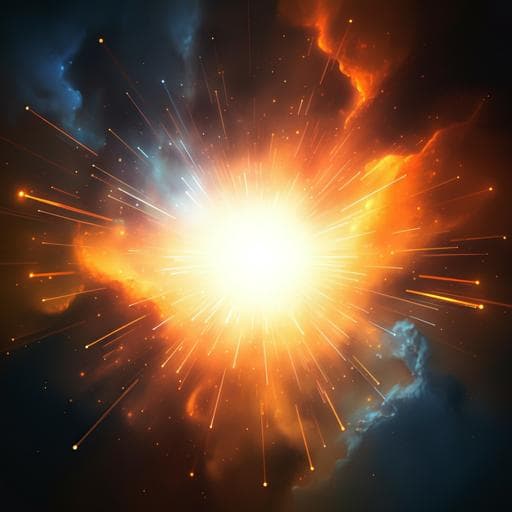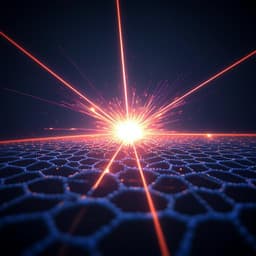
Physics
Single-pulse real-time billion-frames-per-second planar imaging of ultrafast nanoparticle-laser dynamics and temperature in flames
Y. N. Mishra, P. Wang, et al.
Discover the groundbreaking advancements in single-shot laser-sheet compressed ultrafast photography (LS-CUP) for imaging flame-laser dynamics at unprecedented speeds. This research by Yogeshwar Nath Mishra and colleagues reveals real-time insights into soot formation, utilizing laser-induced incandescence and fluorescence to explore the microscopic world of combustion phenomena.
~3 min • Beginner • English
Introduction
The study addresses the need for single-shot, ultrafast two-dimensional imaging to investigate soot inception and growth in hydrocarbon flames. Soot and its precursors (PAHs) have significant impacts on climate and human health, yet their formation dynamics occur on picosecond–nanosecond timescales within non-repeatable, turbulent environments. Existing single-shot planar imaging techniques are limited to a few million frames per second and often rely on multiple pulses, which can thermally alter soot properties. The research proposes and demonstrates laser-sheet compressed ultrafast photography (LS-CUP) to capture, in real time and from a single laser pulse, key species and processes—PAH fluorescence (LIF), soot laser-induced incandescence (LII), and elastic light scattering (ELS)—to map PAH emission, soot temperature, primary particle size, aggregate size, and monomer counts. The objective is to provide comprehensive spatiotemporal evidence supporting soot inception and growth mechanisms, overcoming prior temporal and repeatability limitations.
Literature Review
Prior combustion diagnostics have achieved high-repetition-rate 2D/3D soot imaging using burst-mode lasers and intensified cameras, but are constrained to million-frames-per-second and low fluences to avoid multi-pulse thermal effects. Single-pulse 2D LII imaging at ~10 Mfps suffered from limited pixel counts, poor SNR, and inadequate speed for nanosecond-scale LII decay under high-pressure conditions. Faster lifetime measurements typically rely on point detection (photodiodes/PMTs) or single-shot line imaging via streak cameras, lacking 2D coverage. CUP has previously demonstrated single-shot 2D ultrafast imaging up to 70 trillion fps across diverse physical phenomena and can function with or without active illumination. Laser-sheet planar imaging offers optical sectioning for 2D flame mapping, while ballistic Kerr-based imaging aids turbid sprays but not multi-species ultrafast flame dynamics. The gap remains for single-pulse, real-time, 2D imaging at Gfps rates to capture picosecond–nanosecond species dynamics related to PAH growth, soot inception, and aggregate evolution.
Methodology
The study integrates planar laser-sheet illumination with compressed ultrafast photography (LS-CUP) for single-shot, billion-fps 2D imaging of flame–laser interactions. A laminar, symmetric kerosene diffusion flame is probed using a dual-wavelength pulsed laser (532 nm and 1064 nm), pulse duration ~15 ns, repetition rate 4 Hz, and fluence up to 0.25 J/cm^2. The 1064 nm wavelength excites soot LII while avoiding PAH LIF; 532 nm excites PAH LIF at low fluence (below LII threshold). The laser beam is expanded to 20 mm with peripheral blocking to homogenize intensity, then shaped by a convex cylindrical lens (f = 500 mm) into a sheet ~0.4 mm thick and ~10 mm tall. Laser fluence is tuned via a half-wave plate and polarizer. The flame (with screens to reduce turbulence) is mounted on a translation stage to probe two axial heights: h1 (soot-inception region: PAHs + soot) and h2 (soot-dominated region). Imaging optics form two intermediate image planes; one is captured by a CCD for time-unsheared reference. The other is relayed to a digital micromirror device (DMD) showing a static pseudo-random binary pattern, generating two complementary, spatially encoded paths (+12° ON, −12° OFF). A stereoscopic lens collects these two encoded views, which are then time-sheared and integrated by a streak camera operated with its entrance fully open to preserve 2D x–y spatial information. Spectral filters can be placed at the front optics or in the two encoded paths to select species or enable multi-channel acquisition (e.g., scattering vs LII, two-color LII). Reconstruction of the ultrafast dynamics from the single-shot, encoded, time-sheared measurement uses a regularization-based inverse algorithm based on a forward imaging model. Experimental configurations include: PAH-LIF detection in 350–450 nm band, single-pulse 532 nm excitation at ~0.01 J/cm^2; soot LII via 1064 nm at 0.25 J/cm^2; ELS observed near the laser pulse duration. Imaging speed is 1.25 Gfps with 0.8 ns inter-frame spacing. Derived quantities include PAH-LIF lifetimes via pixel-wise exponential fitting and primary soot particle sizes via time-resolved LII modeling with energy/mass balance, with post-processing (low-pass filtering) to remove isolated spurious estimates.
Key Findings
- LS-CUP achieved single-shot, planar imaging at 1.25 Gfps (0.8 ns frame interval) in a kerosene diffusion flame, capturing multiple species and signals from a single nanosecond pulse.
- PAH-LIF (532 nm excitation at ~0.01 J/cm^2) was recorded over the 350–450 nm band at height h1, showing annular distributions typical of non-premixed flames. The LIF decayed exponentially with spatially resolved lifetimes of ~80–100 ns. Early-time frames provided qualitative PAH concentration maps. Axial symmetry of LIF matched prior laminar diffusion flame results.
- A composite view (from sequential measurements) showed spatial relationships: ELS at outer flame edges; PAHs towards the flame center; soot (LII) covering PAH regions and extending toward the oxidation zone with higher heat release.
- Time-resolved one-color LII (1064 nm, 0.25 J/cm^2) at both heights h2 (soot-dominated) and h1 (soot-inception) exhibited highest intensities at early times (0–16 ns) followed by decay as particles cooled (e.g., diminished by ~128 ns). LII intensities were higher and more symmetric at h2, consistent with greater soot concentration.
- Primary soot particle sizes derived from TiRe-LII modeling showed spatially resolved distributions: approximately 5–25 nm at h2 and 5–18 nm at h1.
- The system enabled dual-channel flexibility for simultaneous species imaging (e.g., scattering and LII, two-color LII), though detailed two-color temperature maps are described generally in the abstract and system overview.
- Experimental parameters: laser sheet ~0.4 mm thick and ~10 mm tall; pulse duration ~15 ns; repetition rate 4 Hz; maximum fluence 0.25 J/cm^2; DMD-based complementary encoding with streak camera time-shearing preserved 2D spatial information; inversion with regularized reconstruction produced spatiotemporal maps and lifetimes.
Discussion
The results demonstrate that LS-CUP overcomes the limitations of existing single-shot combustion diagnostics by providing billion-fps, wide-field, single-pulse 2D imaging of key soot-related processes. Capturing PAH-LIF decay with lifetimes of ~80–100 ns and resolving LII dynamics at nanosecond timescales directly address the central challenge of observing ultrafast species in non-repeatable environments without multi-pulse thermal artifacts. The spatial correlations among ELS, PAHs, and soot (LII) reinforce soot inception and growth models wherein PAHs form near the flame core, soot emerges and expands outward, and scattering indicates aggregate structures at the periphery. Time-resolved LII enabled extraction of primary particle sizes (5–25 nm), providing quantitative, spatially resolved metrics necessary to validate soot formation theories, including cooling-rate-based sizing relationships. The approach’s flexibility (spectral filtering, dual-channel acquisition) supports simultaneous probing of multiple species, enhancing spatiotemporal correlation and offering temperature mapping (via two-color LII) and aggregate characterization (via ELS). Collectively, these findings substantiate LS-CUP as a comprehensive tool to study soot lifecycle and ultrafast combustion kinetics in real time.
Conclusion
This work introduces laser-sheet compressed ultrafast photography (LS-CUP) as a single-shot, billion-fps planar imaging platform for real-time visualization of flame–laser interactions. The system captures PAH-LIF, soot LII, and ELS from a single pulse, delivering spatiotemporal maps of PAH emission, soot temperature (via two-color LII), primary particle size, aggregate size, and monomer counts. Experiments in a kerosene diffusion flame reveal PAH-LIF lifetimes (~80–100 ns) and primary particle sizes (5–25 nm depending on height), yielding strong experimental evidence in support of soot inception and growth models. LS-CUP unifies multiple ultrafast diagnostics in a single framework with high light throughput and sequence depth, suited for non-repeatable, turbulent environments. Future work can extend multi-channel temperature and species measurements to more complex and high-pressure flames, turbulent regimes, and other ultrafast phenomena such as hot plasmas, sonoluminescence, and nuclear fusion.
Limitations
- Reconstruction relies on solving an ill-posed inverse problem; results depend on regularization and may include artifacts, necessitating filtering (e.g., removal of spurious particle size estimates via low-pass filtering).
- Some measurements were performed sequentially (e.g., at different heights), potentially introducing shot-to-shot variations (e.g., slight flame tilt) when comparing spatial distributions.
- Demonstrations were in a laminar, relatively stable kerosene flame; generalization to highly turbulent or high-pressure conditions, while enabled by speed, may require further validation and optimization of SNR and modeling (e.g., very short LII decay times at high pressure).
- Accurate quantification of aggregate size and monomer counts via ELS and two-color LII, while discussed, may require additional calibration and were not fully detailed in the provided results.
- High laser fluences can alter soot properties in multi-pulse schemes; while LS-CUP uses single-pulse excitation to mitigate this, careful fluence control remains essential for quantitative accuracy.
Related Publications
Explore these studies to deepen your understanding of the subject.







